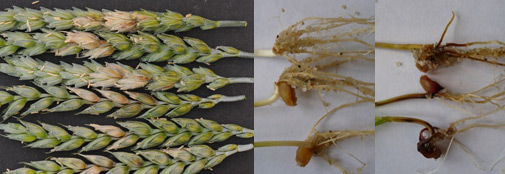 Interactions between Fusarium, cereals and biological control organisms
Interactions between Fusarium, cereals and biological control organisms
Several species of fungi in the genus Fusarium cause severe losses in cereals, causing seedling- and head blight, infecting the developing ear. Whilst the former is primarily of interest through yield loss, the latter is particular of concern since the various species make a range of structurally diverse metabolites, some of which – the mycotoxins – are harmful to humans and livestock.
We have looked at the biology of infection and the conditions which lead to mycotoxin accumulation and found that stressed plants are more susceptible to Fusarium attack and that the levels of mycotoxins accumulating reflect the levels of infection. Current studies concern the natural role of mycotoxins in fungus-fungus (Fusarium-Clonostachys) and plant-fungus (cereal-Fusarium) interactions.
In the new Cerealpath Marie Curie ETN, our goals are to develop novel biological control tools for wheat diseases based on novel endophytic fungi isolated in the project and the extent to which silicon treatment can boost resistance. A cornerstone will be to take genetic variation in the host into account, an aspect which has received very little attention. We will utilise foliar diseases (Septoria blotch, powdery mildew and yellow rust) in these studies as well as Fusarium.
Recent support from the Research Council DFFE, PBD and FOBI via FTP to the project.
Current support: Horizon 2020 Marie Curie ETN “Cerealpath”. Partners: University College Dublin, Lantmännen, Århus University, Danish Technical University, Swedish Agricultural University.
- Collinge DB (2016). Plant Pathogen Resistance Biotechnology.
- Kosawang C, Karlsson M, Vélëz H, Rasmussen PH, Collinge DB, Jensen B, Jensen DF (2014). Zearalenone detoxification by zearalenone hydrolase is important for the antagonistic ability of Clonostachys rosea against mycotoxigenic Fusarium graminearum. Fungal Biology. In press.
- Kosawang C, Karlsson M, Jensen DF, Dilokpimol A, and Collinge DB (2014). Transcriptomic profiling to identify genes involved in Fusarium mycotoxin Deoxynivalenol and Zearalenone tolerance in the mycoparasitic fungus Clonostachys rosea BMC genomics. 15:55.
- Yang F, Jacobsen S, Jørgensen HJL, Collinge DB, Svensson B, Finnie C (2013). Fusarium graminearum and its interactions with cereal heads: studies in the proteomics era. Frontiers in Plant Science 4. doi: 10.3389/fpls.2013.00037
- Nielsen LK, Jensen JD, Nielsen GC, Jensen JE, Spliid NH, Thomsen IK, Justesen IF, Collinge DB, Jørgensen LN (2011) Fusarium Head Blight of Cereals in Denmark: Species Complex and Related Mycotoxins. Phytopathology 101: 960-969
